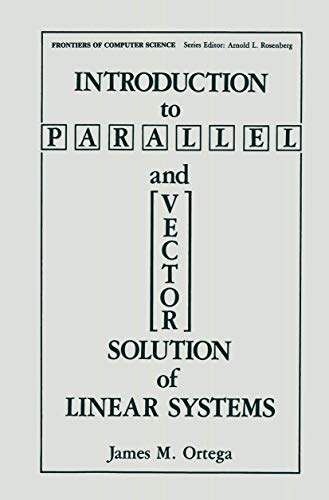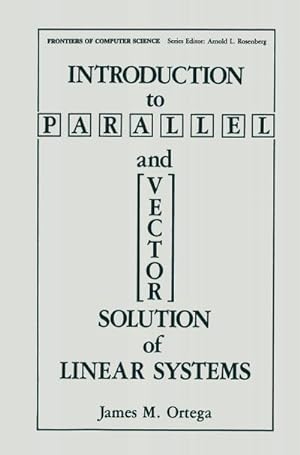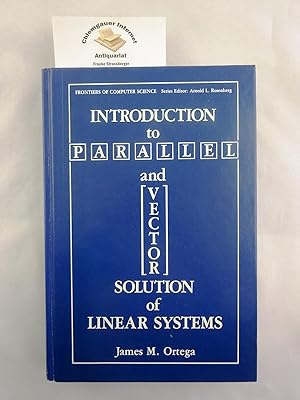Introduction Parallel Vector Solution by Ortega James (25 results)
Search filters
Product Type
- All Product Types
- Books (25)
- Magazines & Periodicals (No further results match this refinement)
- Comics (No further results match this refinement)
- Sheet Music (No further results match this refinement)
- Art, Prints & Posters (No further results match this refinement)
- Photographs (No further results match this refinement)
- Maps (No further results match this refinement)
- Manuscripts & Paper Collectibles (No further results match this refinement)
Condition Learn more
- New (18)
- As New, Fine or Near Fine (4)
- Very Good or Good (2)
- Fair or Poor (No further results match this refinement)
- As Described (1)
Binding
Collectible Attributes
- First Edition (3)
- Signed (No further results match this refinement)
- Dust Jacket (No further results match this refinement)
- Seller-Supplied Images (12)
- Not Print on Demand (18)
Language (1)
Free Shipping
Seller Location
Seller Rating
-
Introduction to Parallel and Vector Solution of Linear Systems
Seller: Better World Books, Mishawaka, IN, U.S.A.
First Edition
Condition: Very Good. 1st Edition. Former library book; may include library markings. Used book that is in excellent condition. May show signs of wear or have minor defects.
-
Introduction to Parallel and Vector Solution of Linear Systems
Seller: ThriftBooks-Atlanta, AUSTELL, GA, U.S.A.
Hardcover. Condition: Good. No Jacket. Missing dust jacket; Pages can have notes/highlighting. Spine may show signs of wear. ~ ThriftBooks: Read More, Spend Less.
-
Introduction to Parallel and Vector Solution of Linear Systems (Frontiers in Computer Science).
Seller: Brentwood Books, Kinnelon, NJ, U.S.A.
Hardcover. Condition: About like new. Almost like new. This is a dark blue glossy hardcover without dust jacket, 1998, Plenum Press, 305pp. As new except upper page edges a little dusty, outer page edges a little foxed. ("Foxing" is light tan spots caused by extended exposure to humid air.) No marks or writing. Nice condition.**We provide professional service and individual attention to your order, daily shipments, and sturdy packaging. FREE TRACKING ON ALL SHIPMENTS WITHIN USA.
-
Introduction to Parallel and Vector Solution of Linear Systems (Frontiers of Computer Science).
Language: English
Published by New York, London: Plenum Press, 1988
ISBN 10: 0306428628 ISBN 13: 9780306428623
Seller: Antiquariat Bernhardt, Kassel, Germany
gebundene Ausgabe. Condition: Sehr gut. Zust: Gutes Exemplar. XI, 305 Seiten, Englisch 578g.
-
Introduction to Parallel and Vector Solution of Linear Systems (Frontiers in Computer Science)
Seller: Toscana Books, AUSTIN, TX, U.S.A.
Hardcover. Condition: new. Excellent Condition.Excels in customer satisfaction, prompt replies, and quality checks.
-
Introduction to Parallel and Vector Solution of Linear Systems (Frontiers in Computer Science)
Seller: ALLBOOKS1, Direk, SA, Australia
Brand new book. Fast ship. Please provide full street address as we are not able to ship to P O box address.
-
Introduction to Parallel and Vector Solution of Linear Systems
Language: English
Published by Kluwer Academic/Plenum Publishers,US, 1988
ISBN 10: 0306428628 ISBN 13: 9780306428623
Seller: Bingo Books 2, Vancouver, WA, U.S.A.
First Edition
Hardcover. Condition: Fine. 1st Edition. hardback book in fine condition.
-
Introduction to Parallel and Vector Solution of Linear Systems (Frontiers in Computer Science)
Seller: Lucky's Textbooks, Dallas, TX, U.S.A.
Condition: New.
-
Introduction to Parallel and Vector Solution of Linear Systems (Frontiers in Computer Science)
Seller: Lucky's Textbooks, Dallas, TX, U.S.A.
Condition: New.
-
Introduction to Parallel and Vector Solution of Linear Systems
Seller: Books Puddle, New York, NY, U.S.A.
Condition: New. pp. 320.
-
Introduction to Parallel and Vector Solution of Linear Systems (Frontiers in Computer Science)
Seller: Mispah books, Redhill, SURRE, United Kingdom
Hardcover. Condition: Like New. Like New. book.
-
Taschenbuch. Condition: Neu. Introduction to Parallel and Vector Solution of Linear Systems | James M. Ortega | Taschenbuch | xi | Englisch | 2013 | Springer | EAN 9781489921147 | Verantwortliche Person für die EU: Springer Verlag GmbH, Tiergartenstr. 17, 69121 Heidelberg, juergen[dot]hartmann[at]springer[dot]com | Anbieter: preigu.
-
Introduction to Parallel and Vector Solution of Linear Systems
Language: English
Published by Springer US, Springer US Mai 2013, 2013
ISBN 10: 1489921141 ISBN 13: 9781489921147
Seller: buchversandmimpf2000, Emtmannsberg, BAYE, Germany
Taschenbuch. Condition: Neu. Neuware -Although the origins of parallel computing go back to the last century, it was only in the 1970s that parallel and vector computers became available to the scientific community. The first of these machines-the 64 processor llliac IV and the vector computers built by Texas Instruments, Control Data Corporation, and then CRA Y Research Corporation-had a somewhat limited impact. They were few in number and available mostly to workers in a few government laboratories. By now, however, the trickle has become a flood. There are over 200 large-scale vector computers now installed, not only in government laboratories but also in universities and in an increasing diversity of industries. Moreover, the National Science Foundation's Super computing Centers have made large vector computers widely available to the academic community. In addition, smaller, very cost-effective vector computers are being manufactured by a number of companies. Parallelism in computers has also progressed rapidly. The largest super computers now consist of several vector processors working in parallel. Although the number of processors in such machines is still relatively small (up to 8), it is expected that an increasing number of processors will be added in the near future (to a total of 16 or 32). Moreover, there are a myriad of research projects to build machines with hundreds, thousands, or even more processors. Indeed, several companies are now selling parallel machines, some with as many as hundreds, or even tens of thousands, of processors.Springer Verlag GmbH, Tiergartenstr. 17, 69121 Heidelberg 320 pp. Englisch.
-
Introduction to Parallel and Vector Solution of Linear Systems
Language: English
Published by Springer US, Springer New York Apr 1988, 1988
ISBN 10: 0306428628 ISBN 13: 9780306428623
Seller: buchversandmimpf2000, Emtmannsberg, BAYE, Germany
Buch. Condition: Neu. Neuware -Although the origins of parallel computing go back to the last century, it was only in the 1970s that parallel and vector computers became available to the scientific community. The first of these machines-the 64 processor llliac IV and the vector computers built by Texas Instruments, Control Data Corporation, and then CRA Y Research Corporation-had a somewhat limited impact. They were few in number and available mostly to workers in a few government laboratories. By now, however, the trickle has become a flood. There are over 200 large-scale vector computers now installed, not only in government laboratories but also in universities and in an increasing diversity of industries. Moreover, the National Science Foundation's Super computing Centers have made large vector computers widely available to the academic community. In addition, smaller, very cost-effective vector computers are being manufactured by a number of companies. Parallelism in computers has also progressed rapidly. The largest super computers now consist of several vector processors working in parallel. Although the number of processors in such machines is still relatively small (up to 8), it is expected that an increasing number of processors will be added in the near future (to a total of 16 or 32). Moreover, there are a myriad of research projects to build machines with hundreds, thousands, or even more processors. Indeed, several companies are now selling parallel machines, some with as many as hundreds, or even tens of thousands, of processors.Springer Verlag GmbH, Tiergartenstr. 17, 69121 Heidelberg 324 pp. Englisch.
-
Introduction to Parallel and Vector Solution of Linear Systems
Language: English
Published by Springer US, Springer US, 2013
ISBN 10: 1489921141 ISBN 13: 9781489921147
Seller: AHA-BUCH GmbH, Einbeck, Germany
Taschenbuch. Condition: Neu. Druck auf Anfrage Neuware - Printed after ordering - Although the origins of parallel computing go back to the last century, it was only in the 1970s that parallel and vector computers became available to the scientific community. The first of these machines-the 64 processor llliac IV and the vector computers built by Texas Instruments, Control Data Corporation, and then CRA Y Research Corporation-had a somewhat limited impact. They were few in number and available mostly to workers in a few government laboratories. By now, however, the trickle has become a flood. There are over 200 large-scale vector computers now installed, not only in government laboratories but also in universities and in an increasing diversity of industries. Moreover, the National Science Foundation's Super computing Centers have made large vector computers widely available to the academic community. In addition, smaller, very cost-effective vector computers are being manufactured by a number of companies. Parallelism in computers has also progressed rapidly. The largest super computers now consist of several vector processors working in parallel. Although the number of processors in such machines is still relatively small (up to 8), it is expected that an increasing number of processors will be added in the near future (to a total of 16 or 32). Moreover, there are a myriad of research projects to build machines with hundreds, thousands, or even more processors. Indeed, several companies are now selling parallel machines, some with as many as hundreds, or even tens of thousands, of processors.
-
Introduction to Parallel and Vector Solution of Linear Systems
Language: English
Published by Springer US, Springer New York, 1988
ISBN 10: 0306428628 ISBN 13: 9780306428623
Seller: AHA-BUCH GmbH, Einbeck, Germany
Buch. Condition: Neu. Druck auf Anfrage Neuware - Printed after ordering - Although the origins of parallel computing go back to the last century, it was only in the 1970s that parallel and vector computers became available to the scientific community. The first of these machines-the 64 processor llliac IV and the vector computers built by Texas Instruments, Control Data Corporation, and then CRA Y Research Corporation-had a somewhat limited impact. They were few in number and available mostly to workers in a few government laboratories. By now, however, the trickle has become a flood. There are over 200 large-scale vector computers now installed, not only in government laboratories but also in universities and in an increasing diversity of industries. Moreover, the National Science Foundation's Super computing Centers have made large vector computers widely available to the academic community. In addition, smaller, very cost-effective vector computers are being manufactured by a number of companies. Parallelism in computers has also progressed rapidly. The largest super computers now consist of several vector processors working in parallel. Although the number of processors in such machines is still relatively small (up to 8), it is expected that an increasing number of processors will be added in the near future (to a total of 16 or 32). Moreover, there are a myriad of research projects to build machines with hundreds, thousands, or even more processors. Indeed, several companies are now selling parallel machines, some with as many as hundreds, or even tens of thousands, of processors.
-
Introduction to Parallel and Vector Solution of Linear Systems (Frontiers in Computer Science)
Seller: Revaluation Books, Exeter, United Kingdom
Paperback. Condition: Brand New. reprint edition. 316 pages. 9.26x6.11x0.73 inches. In Stock.
-
Introduction to Parallel and Vector Solution of Linear Systems (Frontiers of Computer Science). ISBN 10: 0306428628 / ISBN 13: 9780306428623
Language: English
Published by New York, London: Plenum Press, 1988
Seller: Chiemgauer Internet Antiquariat GbR, Altenmarkt, BAY, Germany
First Edition
Originalpappband. 24cm. Condition: Wie neu. First edition. IX,305 pages. Index. In EXCELLENT shape. ( We offer a lot of books on PHYSICS and MATHEMATICS on stock in EXCELLENT shape) Sprache: Englisch Gewicht in Gramm: 600.
-
Introduction to Parallel and Vector Solution of Linear Systems
Language: English
Published by Springer US Mai 2013, 2013
ISBN 10: 1489921141 ISBN 13: 9781489921147
Seller: BuchWeltWeit Ludwig Meier e.K., Bergisch Gladbach, Germany
Taschenbuch. Condition: Neu. This item is printed on demand - it takes 3-4 days longer - Neuware -Although the origins of parallel computing go back to the last century, it was only in the 1970s that parallel and vector computers became available to the scientific community. The first of these machines-the 64 processor llliac IV and the vector computers built by Texas Instruments, Control Data Corporation, and then CRA Y Research Corporation-had a somewhat limited impact. They were few in number and available mostly to workers in a few government laboratories. By now, however, the trickle has become a flood. There are over 200 large-scale vector computers now installed, not only in government laboratories but also in universities and in an increasing diversity of industries. Moreover, the National Science Foundation's Super computing Centers have made large vector computers widely available to the academic community. In addition, smaller, very cost-effective vector computers are being manufactured by a number of companies. Parallelism in computers has also progressed rapidly. The largest super computers now consist of several vector processors working in parallel. Although the number of processors in such machines is still relatively small (up to 8), it is expected that an increasing number of processors will be added in the near future (to a total of 16 or 32). Moreover, there are a myriad of research projects to build machines with hundreds, thousands, or even more processors. Indeed, several companies are now selling parallel machines, some with as many as hundreds, or even tens of thousands, of processors. 320 pp. Englisch.
-
Introduction to Parallel and Vector Solution of Linear Systems
Language: English
Published by Springer US Apr 1988, 1988
ISBN 10: 0306428628 ISBN 13: 9780306428623
Seller: BuchWeltWeit Ludwig Meier e.K., Bergisch Gladbach, Germany
Buch. Condition: Neu. This item is printed on demand - it takes 3-4 days longer - Neuware -Although the origins of parallel computing go back to the last century, it was only in the 1970s that parallel and vector computers became available to the scientific community. The first of these machines-the 64 processor llliac IV and the vector computers built by Texas Instruments, Control Data Corporation, and then CRA Y Research Corporation-had a somewhat limited impact. They were few in number and available mostly to workers in a few government laboratories. By now, however, the trickle has become a flood. There are over 200 large-scale vector computers now installed, not only in government laboratories but also in universities and in an increasing diversity of industries. Moreover, the National Science Foundation's Super computing Centers have made large vector computers widely available to the academic community. In addition, smaller, very cost-effective vector computers are being manufactured by a number of companies. Parallelism in computers has also progressed rapidly. The largest super computers now consist of several vector processors working in parallel. Although the number of processors in such machines is still relatively small (up to 8), it is expected that an increasing number of processors will be added in the near future (to a total of 16 or 32). Moreover, there are a myriad of research projects to build machines with hundreds, thousands, or even more processors. Indeed, several companies are now selling parallel machines, some with as many as hundreds, or even tens of thousands, of processors. 324 pp. Englisch.
-
Introduction to Parallel and Vector Solution of Linear Systems
Seller: moluna, Greven, Germany
Gebunden. Condition: New. Dieser Artikel ist ein Print on Demand Artikel und wird nach Ihrer Bestellung fuer Sie gedruckt. Although the origins of parallel computing go back to the last century, it was only in the 1970s that parallel and vector computers became available to the scientific community. The first of these machines-the 64 processor llliac IV and the vector computers.
-
Introduction to Parallel and Vector Solution of Linear Systems
Seller: moluna, Greven, Germany
Condition: New. Dieser Artikel ist ein Print on Demand Artikel und wird nach Ihrer Bestellung fuer Sie gedruckt. Although the origins of parallel computing go back to the last century, it was only in the 1970s that parallel and vector computers became available to the scientific community. The first of these machines-the 64 processor llliac IV and the vector computers.
-
Introduction to Parallel and Vector Solution of Linear Systems
Seller: preigu, Osnabrück, Germany
Buch. Condition: Neu. Introduction to Parallel and Vector Solution of Linear Systems | James M. Ortega | Buch | xi | Englisch | 1988 | Springer US | EAN 9780306428623 | Verantwortliche Person für die EU: Springer Verlag GmbH, Tiergartenstr. 17, 69121 Heidelberg, juergen[dot]hartmann[at]springer[dot]com | Anbieter: preigu Print on Demand.
-
Introduction to Parallel and Vector Solution of Linear Systems
Seller: Majestic Books, Hounslow, United Kingdom
Condition: New. Print on Demand pp. 320 49:B&W 6.14 x 9.21 in or 234 x 156 mm (Royal 8vo) Perfect Bound on White w/Gloss Lam.
-
Introduction to Parallel and Vector Solution of Linear Systems
Seller: Biblios, Frankfurt am main, HESSE, Germany
Condition: New. PRINT ON DEMAND pp. 320.















